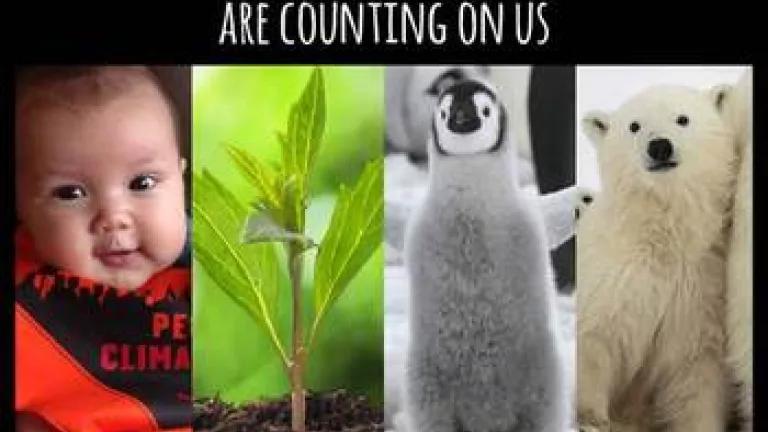
Next week over 125 Heads of Government will convene in New York City to outline actions that they are prepared to take now and in the future to address climate change. This isn’t the first time that leaders have engaged deeply on this issue, nor will it be the last time as the world drives towards a stronger international agreement in Paris 2015. World leaders can show that they are preparing to take the bold steps necessary to leave our children and grandchildren with a world that avoids the worst impacts of climate change.
Countries won’t finalize any agreements towards the Paris agreement next week, but they can show that they are serious about taking action at home right now while preparing to make even deeper commitments for the next decade. As NRDC’s President put it: this will be a time of reckoning on climate change.
So leaders need to…
Listen to the people on the street. World leaders agreed to a one-day Summit on climate change in New York. And instead of this being a stale affair filled with reams of speeches and vague declarations, people around the world decided to show the leaders that “we have their back” as they take action on climate change and we are unified in our demand for strong action. Record numbers of people will be on the streets in New York demanding action on climate change, and citizens around the world will join in events in other major cities. So as world leaders arrive in New York they will be visually reminded that their citizens no longer accept inaction or excuses.
Detail to the world their plans to meet their current commitments. In Copenhagen countries accounting for over 80 percent of the world’s carbon pollution made specific commitments to curb their pollution. Since then most countries have been rolling up their sleeves and implementing new laws and policies to reduce their pollution. This is evident in the US where President Obama is a year into implementing his Climate Action Plan and his Administration is beginning to implement key measures to put the US on track to meet its commitment to cut emissions 17 percent below 2005 levels by 2020 (as my colleague David Doniger outlined). You can see it in the fact that China has been the leader in renewable energy investments several years in a row and is seriously considering capping its coal consumption that is driving air pollution and climate change (as my colleague Alvin Lin summarized). Countries like India are spurring solar energy deployment at astounding rates and leading states like Andhra Pradesh and Telangana are implementing mandatory building codes to curb the energy use from their fast expanding building stock (as Anjali Jaiswal details). Or in Chile where the country is building renewable energy thanks largely to a new law requiring that the country generate a minimum amount of its electricity from renewables (as my colleague Amanda Maxwell has documented). These countries are proving that they can address climate change and create economic opportunities for their citizens. As the recent report from the New Climate Economy initiative summarized: countries at all levels of income now have the opportunity to build lasting economic growth at the same time as reducing the immense risks of climate change.
Obviously there are some laggards that need to quickly turn the corner. Canada, for one, is clearly off-track to meet its climate commitment to cut its emissions 17% below 2005 levels by 2020 thanks in large part to its tar sands expansion (as my colleague Anthony Swift highlighted).
Step up their commitments to “use all the tools in the toolbox” and work with others to deliver actions on the ground. This meeting will also be a chance for major companies, financial institutions, governments, and others to show that they are prepared to act on things right now that are within their direct control. They don’t have to wait for new agreements to know that they should no longer use commodities in their supply-chain that are driving deforestation, they can act now to reduce “super greenhouse” gases called hydrofluorcarbons, and that their dollars should no longer drive the wrong investments. As my colleague Jacob Scherr discussed these are critical tools in our global efforts to address climate change since we need all the action we can get.
Show that they are serious about securing a strong international agreement next year. The Climate Summit in New York will help to focus world leaders on the key decisions they will have to make next year if the Paris 2015 agreement is to be remembered as a critical moment that the world showed it was serious about combatting climate change. They will have to outline in their speeches that they are preparing for real action in Paris, that they will set aside their differences and find common ways to work together to address climate change, and that they will empower their negotiators to formulate an ambitious agreement. This won’t show up in a final decree from the gathered Heads of Government, but will more likely be evident in the tenor of their speeches, the side conversations between leaders, and their willingness to focus on what they are prepared to commit to next year rather than a simple regurgitation of what they aren’t prepared to do.
We need a can-do spirit going into next year. And we need leaders that are prepared to be known as the ones that turned the corner on climate change. History will look back favorably on leaders that rise to the challenge and future generations will shower anger at those that didn’t.
Next week will be another important opportunity to show where leaders stand.

